Pura Lempuyang, an ancient and sacred temple perched atop Mount Lempuyang in Bali, Indonesia, captivates visitors with its stunning architecture, cultural significance, and the iconic “Gate of Heaven” viewpoint. This revered temple offers a glimpse into the rich history and spiritual traditions of the Balinese people.
Nestled amidst lush greenery, Pura Lempuyang is a testament to the ingenuity and artistry of Balinese craftsmen. Its intricate carvings, towering gates, and serene atmosphere create a sense of awe and tranquility. As you ascend the sacred stairs leading to the temple, you’ll be rewarded with breathtaking views of the surrounding countryside.
Pura Lempuyang Luhur
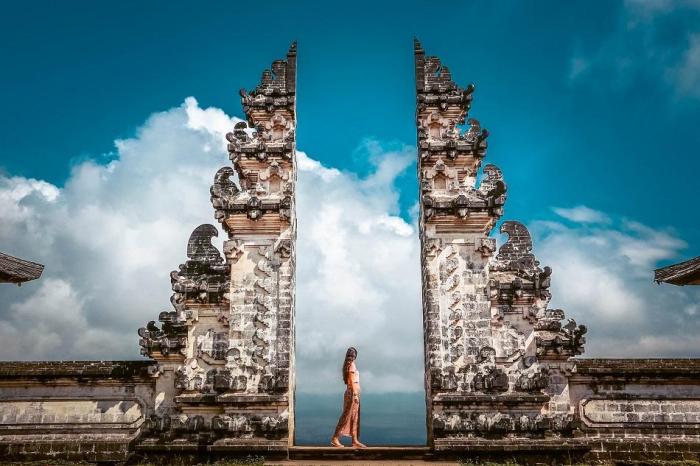
Pura Lempuyang Luhur is a magnificent Hindu temple perched atop Mount Lempuyang in the eastern part of Bali, Indonesia. It is one of the island’s most sacred and revered temples, attracting countless pilgrims and tourists alike.
The temple complex comprises seven levels, each with its own unique set of shrines and courtyards. The ascent to the summit, which is reached via a steep staircase, is considered a spiritual journey, with each level representing a different stage of purification and enlightenment.
Historical Significance and Cultural Importance, Pura lempuyang
Pura Lempuyang Luhur is believed to have been founded in the 10th century by Mpu Kuturan, a Javanese priest who brought Hinduism to Bali. The temple has played a significant role in Balinese history and culture, serving as a center for religious ceremonies, festivals, and pilgrimages.
It is particularly associated with the deity Shiva, the god of destruction and creation, and is considered one of the most important temples in Bali dedicated to this deity.
Architectural Features and Design Elements
Pura Lempuyang Luhur is renowned for its stunning architecture and intricate design. The temple complex is characterized by its towering gateways, known as candi bentar, which are adorned with elaborate carvings and sculptures.
The courtyards are filled with shrines, pavilions, and towering meru towers, which are multi-tiered structures that represent Mount Meru, the sacred mountain of the Hindu cosmos.
Gate of Heaven
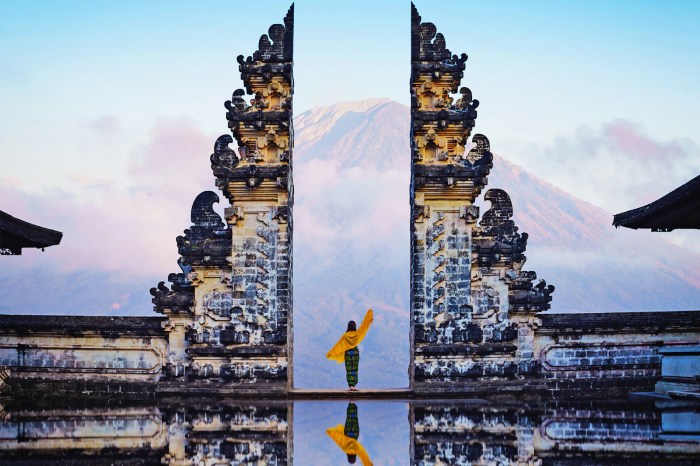
Perched atop Mount Lempuyang, the iconic “Gate of Heaven” viewpoint offers a breathtaking panorama that has captivated travelers worldwide. This celestial portal, known as Candi Bentar in Balinese architecture, symbolizes the entrance to the sacred realm of Pura Lempuyang Luhur.
The gate’s significance stems from its connection to the ancient Hindu temple complex. Believers ascend the steep staircase to the temple, passing through the Gate of Heaven as a symbolic purification ritual before entering the holy sanctuary.
Tips for Stunning Photographs
- Arrive early:Beat the crowds and capture the serene beauty of the gate during sunrise or sunset.
- Choose a clear day:Cloudless skies enhance the visibility of Mount Agung in the background.
- Experiment with angles:Capture the gate from different perspectives to create unique compositions.
- Use a wide-angle lens:Capture the vast expanse of the landscape and the towering gate.
- Pay attention to framing:Incorporate the surrounding elements, such as the lush vegetation and distant mountains, to enhance the impact of your shots.
Trekking to the Temple

Reaching Pura Lempuyang Luhur requires a scenic trek through lush forests and stunning landscapes. Multiple routes are available, catering to different fitness levels and time constraints.
Trekking Routes
- Main Route:The most popular and direct path, starting from the base of Mount Lempuyang. It covers approximately 1,700 steps and takes around 1-2 hours to ascend. The trail is well-maintained and offers breathtaking views of the surrounding countryside.
- Pengubengan Route:A slightly longer and more challenging route, beginning from the village of Pengubengan. It involves ascending 2,000 steps and takes around 2-3 hours to complete. This path offers panoramic views of the coast and the nearby islands.
- Shortcut Route:A shorter and steeper alternative, starting from the parking area near the temple. It consists of approximately 600 steps and can be completed in about 30-45 minutes. However, this route is recommended only for experienced hikers due to its steep incline.
Along the trails, hikers can immerse themselves in the beauty of the natural surroundings. Lush vegetation, towering trees, and vibrant flowers create a tranquil and picturesque atmosphere. The air is fresh and invigorating, making the trek an enjoyable experience for nature enthusiasts.
Pura Lempuyang is a beautiful temple located in the highlands of Bali, offering breathtaking views of the surrounding countryside. If you’re looking for a more lively experience, Kuta Bali is a great place to go. With its vibrant nightlife and bustling atmosphere, Kuta Bali is a popular destination for tourists.
After a day of exploring Kuta Bali, you can head back to Pura Lempuyang for a peaceful evening, enjoying the serenity of the temple and the stunning views it offers.
Cultural Practices and Rituals

Pura Lempuyang Luhur is a sacred site deeply embedded in Balinese religious traditions and beliefs. Various cultural practices and rituals are performed at the temple, each holding significant meaning and symbolism.
Offerings, ceremonies, and prayers are integral aspects of worship at Pura Lempuyang Luhur. Devotees bring offerings of flowers, incense, and food to the temple as a form of gratitude and respect for the divine. These offerings are believed to strengthen the connection between the physical and spiritual realms.
Ceremonies
Ceremonies held at Pura Lempuyang Luhur include the daily morning and evening prayers, as well as special ceremonies during religious festivals. The most significant ceremony is the annual Piodalan, a temple anniversary celebration that takes place over several days. During the Piodalan, elaborate rituals are performed to honor the temple’s patron deities and to purify the temple grounds.
Pura Lempuyang is a popular tourist destination in Bali, known for its stunning views of Mount Agung. If you’re looking for a more laid-back experience, consider visiting Canggu Bali , a trendy coastal town with a vibrant nightlife and plenty of surf spots.
After exploring Canggu, make sure to return to Pura Lempuyang for a truly unforgettable experience.
Prayers
Prayers are an essential part of worship at Pura Lempuyang Luhur. Devotees offer prayers for blessings, guidance, and protection. Prayers are often recited in Sanskrit, the ancient language of Hindu scriptures, and are accompanied by specific hand gestures and postures.
Role in Local Traditions and Beliefs
Pura Lempuyang Luhur holds a central role in the religious traditions and beliefs of the local community. The temple is considered a sacred place where devotees can connect with the divine and seek spiritual guidance. It is also a place of pilgrimage for Balinese Hindus from all over the island.
Tourism and Development
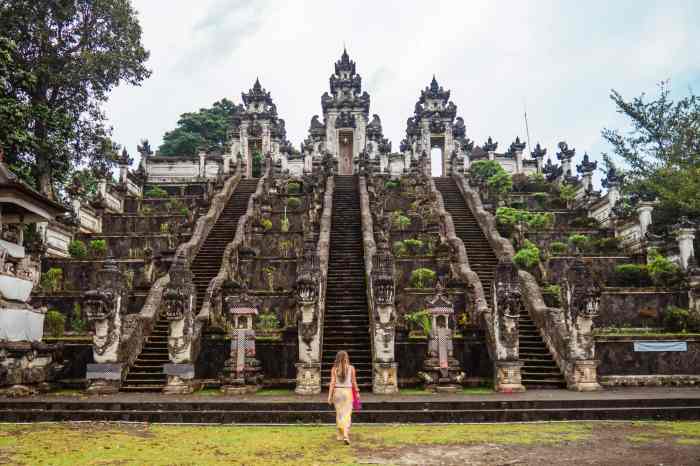
The surge in tourism at Pura Lempuyang Luhur has had a significant impact on the temple and its surroundings. While it has brought economic benefits to the local community, it has also posed challenges to preserving the temple’s cultural heritage and managing the increased footfall.
Increased visitation has led to infrastructure development around the temple, including new roads, parking lots, and tourist facilities. This development has improved accessibility and convenience for visitors but has also altered the landscape and potentially disrupted the serene atmosphere of the temple.
Challenges and Opportunities
- Environmental impact:The influx of tourists can strain the temple’s natural resources, such as water and waste management. Additionally, increased foot traffic can damage the temple’s delicate structures and surrounding environment.
- Cultural impact:The presence of large crowds can disrupt religious ceremonies and rituals, potentially diminishing the spiritual significance of the temple for local worshippers.
- Economic opportunities:Tourism has created job opportunities and stimulated economic growth in the local area. However, it is essential to ensure that the benefits are equitably distributed and that the community retains control over tourism development.
Strategies for Sustainable Tourism Development
To mitigate the challenges and harness the opportunities presented by increased tourism, it is crucial to implement sustainable tourism development strategies. These strategies should focus on:
- Infrastructure management:Regulating the number of visitors, implementing traffic management plans, and providing alternative transportation options to reduce congestion and environmental impact.
- Cultural preservation:Establishing guidelines for respectful behavior, limiting access to sensitive areas during ceremonies, and promoting cultural education among visitors.
- Community engagement:Involving the local community in tourism planning and decision-making to ensure that the benefits of tourism are shared equitably and that the temple’s cultural heritage is preserved.
- Environmental protection:Implementing waste management systems, promoting sustainable practices, and educating visitors about the importance of protecting the temple’s natural environment.
Related Temples and Sites
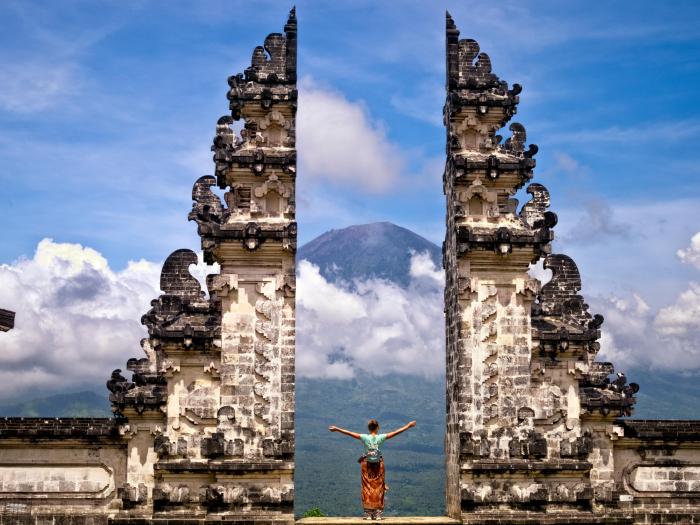
Pura Lempuyang Luhur is not the only significant temple in the area. Several other notable temples and cultural sites are located in its vicinity, each with its unique history and cultural significance.
These temples share historical connections and architectural similarities with Pura Lempuyang Luhur, contributing to the rich cultural tapestry of the region.
Temples in the Vicinity
- Pura Penataran Agung Lempuyang: Located at the base of Mount Lempuyang, this temple is the main temple of the Lempuyang Temple complex. It is dedicated to the deity Batara Brahma and features a large courtyard, several shrines, and a towering pagoda.
- Pura Goa Lawah: Also known as the “Bat Cave Temple,” this temple is located on the coast near Candidasa. It is known for its sacred cave, which is believed to be inhabited by thousands of bats. The temple is dedicated to the deity Batara Goa and is a popular pilgrimage site.
- Pura Besakih: Located on the slopes of Mount Agung, Pura Besakih is the largest and most important temple in Bali. It is a complex of 23 temples dedicated to various deities, including the Trimurti (Brahma, Vishnu, and Shiva). Pura Besakih is a UNESCO World Heritage Site and a major pilgrimage destination.
Similarities and Historical Connections
The temples in the vicinity of Pura Lempuyang Luhur share several similarities. They are all dedicated to Hindu deities and feature traditional Balinese architecture. They also play an important role in the religious and cultural life of the local community.
Historically, these temples have been connected through religious ceremonies and festivals. For example, the annual Pura Besakih festival attracts pilgrims from all over Bali, including those from the Lempuyang Temple complex.
Comparison of Key Features
| Temple | Location | Dedication | Key Features |
|---|---|---|---|
| Pura Lempuyang Luhur | Mount Lempuyang | Batara Shiva | Gate of Heaven, seven-tiered pagoda |
| Pura Penataran Agung Lempuyang | Base of Mount Lempuyang | Batara Brahma | Large courtyard, several shrines, pagoda |
| Pura Goa Lawah | Candidasa | Batara Goa | Sacred cave with thousands of bats |
| Pura Besakih | Mount Agung | Trimurti (Brahma, Vishnu, Shiva) | Largest and most important temple in Bali, UNESCO World Heritage Site |
Legends and Folklore
Pura Lempuyang Luhur is steeped in captivating legends and folklore that have shaped its spiritual significance. These tales, passed down through generations, offer insights into the temple’s origins, sacredness, and the beliefs of the Balinese people.
Origins and Sacredness
Legend has it that the temple was founded by the legendary sage Rsi Markandeya, who meditated on Mount Lempuyang to seek divine guidance. During his meditation, he was blessed with a vision of Mount Agung, which he believed to be the abode of the gods.
Inspired by this vision, he established Pura Lempuyang Luhur as a sacred site to honor the deities of Mount Agung.
Gate of Heaven
Another prevalent legend revolves around the temple’s reputation as the “Gate of Heaven.” It is believed that those who make the arduous trek to the summit of Mount Lempuyang and reach the temple will be blessed with good fortune and spiritual enlightenment.
After the Pura Lempuyang temple in Bali, you might want to rest at a singapore hotel before continuing your journey. Consider booking one of the best hotels in Singapore to ensure a comfortable and enjoyable stay. The trip to Pura Lempuyang is an enriching experience, and it’s recommended to plan your accommodation in advance.
The “Gate of Heaven” is represented by the Candi Bentar, a split gate found at the entrance of the temple, symbolizing the passage between the mortal and divine realms.
Storytelling and Mythology
The legends and folklore surrounding Pura Lempuyang Luhur play a vital role in the temple’s cultural context. Storytelling and mythology have been integral to Balinese culture for centuries, serving to convey religious beliefs, historical events, and moral lessons. These tales have shaped the temple’s significance and continue to inspire the faith and devotion of pilgrims and visitors alike.
Artistic Representations
Pura Lempuyang Luhur’s cultural and historical significance is reflected in various artistic representations, including paintings, sculptures, and traditional crafts. These artworks capture the temple’s architectural beauty, sacred symbolism, and its place in Balinese culture.
Traditional Balinese paintings depict the temple in vibrant colors, with intricate details and symbolic motifs. The temple’s iconic split gate, known as the “Gate of Heaven,” is a common subject, often adorned with mythical creatures and deities. These paintings serve as a visual record of the temple’s history and its importance in Balinese mythology.
Sculptures
Stone and wood carvings depict Pura Lempuyang Luhur in intricate detail, showcasing the temple’s architectural grandeur. These sculptures often adorn temple walls, gates, and shrines, serving as a permanent reminder of the temple’s sacred status. The carvings depict scenes from Hindu mythology, such as the battle between good and evil, and symbolize the temple’s role as a place of spiritual purification.
Traditional Crafts
Pura Lempuyang Luhur also inspires traditional crafts, such as woodcarving, metalworking, and weaving. Artisans create intricate offerings, such as masks, statues, and textiles, that are used in temple ceremonies and rituals. These crafts showcase the temple’s cultural significance and provide a tangible connection between the temple and the local community.
Virtual Experiences
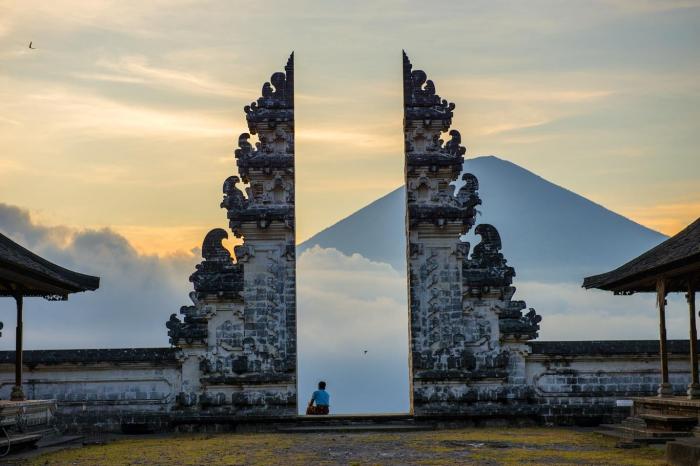
With the advancement of technology, virtual experiences have emerged as a means to explore cultural landmarks remotely. Pura Lempuyang Luhur is no exception, with several virtual tours and online resources available to provide a glimpse of this sacred site.
These experiences offer numerous benefits, including accessibility for individuals who may not be able to physically visit the temple due to distance, mobility issues, or financial constraints. Virtual tours allow users to explore the temple grounds, view its intricate architecture, and learn about its cultural significance from the comfort of their own homes.
Recommended Virtual Tours
- Google Street View:Provides a panoramic virtual tour of the temple complex, including the iconic Gate of Heaven.
- AirPano:Offers high-resolution aerial and 360-degree virtual tours of the temple and its surroundings.
- TripAdvisor Virtual Tour:Features a virtual tour with interactive hotspots that provide additional information and insights.
Limitations of virtual experiences include the lack of physical immersion and the absence of sensory elements such as the scent of incense or the sound of temple bells. Additionally, virtual tours may not fully capture the grandeur and atmosphere of the actual temple.
Conclusive Thoughts: Pura Lempuyang
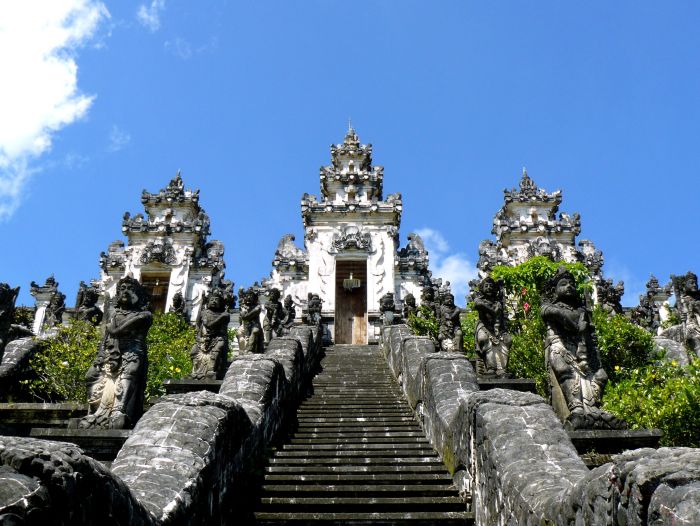
Pura Lempuyang stands as a testament to the enduring spirit of the Balinese people. Its architectural beauty, cultural significance, and the iconic “Gate of Heaven” have made it a must-visit destination for travelers seeking a glimpse into the heart and soul of Bali.
Whether you’re a history buff, a nature lover, or simply seeking a spiritual retreat, Pura Lempuyang offers an unforgettable experience that will stay with you long after your visit.
Questions and Answers
Is Pura Lempuyang difficult to trek to?
The trek to Pura Lempuyang can be challenging, especially during the rainy season. However, there are multiple routes available, and the difficulty level varies depending on the route you choose.
What is the significance of the “Gate of Heaven”?
The “Gate of Heaven” is a popular viewpoint that offers a breathtaking view of Mount Agung, the highest mountain in Bali. It has become an iconic symbol of Pura Lempuyang and a must-visit spot for photographers.
Is Pura Lempuyang open to non-Hindus?
Yes, Pura Lempuyang is open to visitors of all faiths. However, it is important to dress respectfully and observe local customs when visiting the temple.